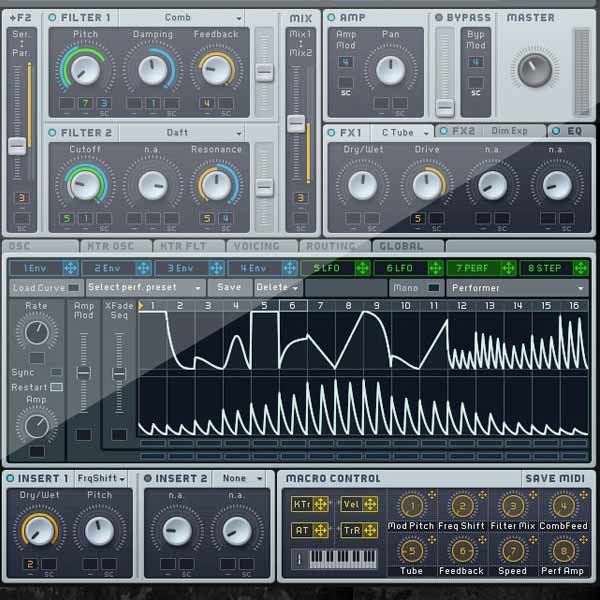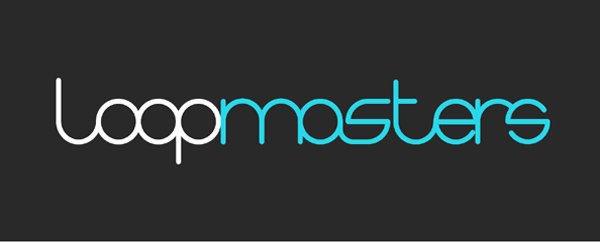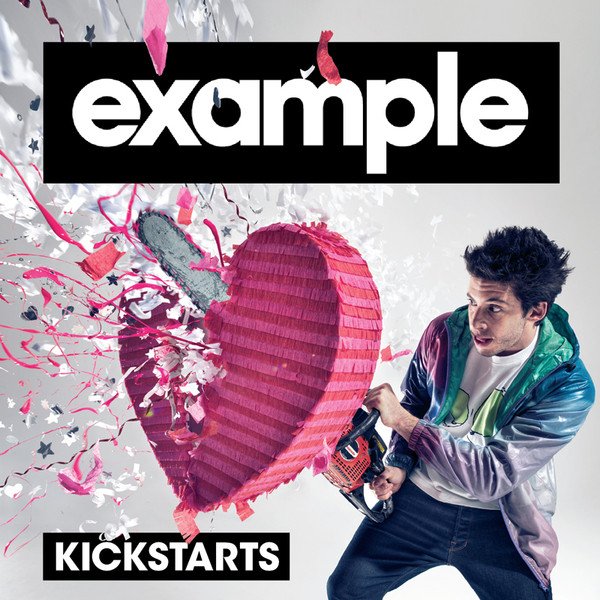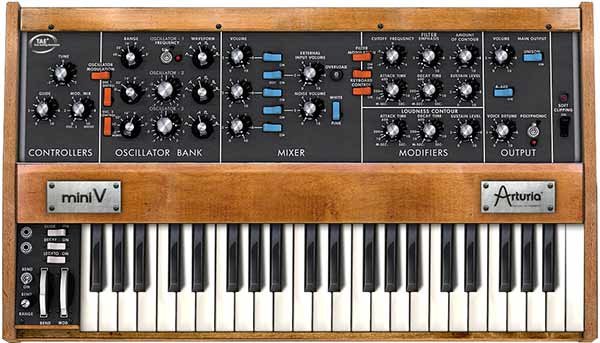
Advanced Synth Programming Tips
There are many tutorials on synth programming for beginners, but lots of musicians reach a plateau and never get beyond fairly basic synthesizer programming. This series aims to give you some pointers on taking your patch creation to the next level. What characterizes a good patch?
Consider timbre, dynamics and expressiveness.
So you got your head around envelopes and filters. You know your ADSR from your VCO and you can analyse most commercial synth patches and understand what’s going on. But when you sit down to program a new patch, the results are often disappointing, or sound like something is missing. If this sounds like you then hopefully some of the tips on this page will help you to quickly and drastically improve your softsynth patching skills. Later on there are some very practical tips. So fire up your favourite “bread and butter” synth and experiment as you read.
The Presets.
There are some amazing genre-defining preset libraries available to buy online now for next to nothing. All the big synths are catered for including Massive, Sylenth, and Ableton Operator. Some muzos are happy to buy patches online from the likes of Loopmasters / Plugin Botique, and there is nothing wrong with that. The word “preset” shouldn’t be a dirty word, especially when there are so many thousands of patches to choose from, and so many ways each synth preset can be adjusted, played, effected, mixed and contextualized!

Loopmasters have a huge library of synth presets.
So why go advanced?
Probably one of the best things about being a proficient synth patch programmer is the ability to create a sound from the one you imagine in your head, or the one you want to imitate in that awesome track on iTunes. This skill will save you money on patches, (and unnecessary purchases of new VST plugins), as well as time browsing presets, hoping to come across something that fits the bill. Knowing advanced synthesis also enables you to create extremely unique sounds to define your sound, or to focus your energy on the distinctive sound of your chosen genre. It’s also fun as Hell.
Lets talk about timbre.
Timbre is the character and quality of a musical sound. The initial timbre in the signal chain of a synth comes from the oscillators. We might describe a sine wave as being smooth, eery or watery, while a saw wave might sound buzzy or harsh. It would be easy to think that having a small number of oscillators such as saw/sine/square would be extremely limiting in terms of timbre but this is not the case. Aside from the oscillators, timbre can also be effected by a multitude of other parameters, some of which are easily overlooked by beginners. Ultimately, whether you use a simple saw wave, or a complex hand drawn waveform in U-he Zebra, your synth patch requires other modulations to have an interesting, characteristic sound.
Pitch modulation / Vibrato.
Probably the most underused, and criminally underappreciated synth tweak there is. Perhaps the assumption is that pitch modulation is only useful for special effects. Subtle changes in pitch occur in vocals and real world instruments and can have a powerful effect of how our brains characterize a sound, so ignore pitch mod at your peril. A small, quick rise in pitch at the early stages of an envelope can add a fun, mellow touch to a patch, or form part of a funky “wapp wapp” sound. A quick drop in pitch can add a raspy, percussive or bell-like edge. Random or velocity controlled tuning variations can lend a vintage authenticity to fat leads, or add a delicate touch to twinkling keys. Varying levels of vibrato (often an LFO modulating the pitch) can produce anything from a subtle vocal quality, to a haunting, alien texture, such as the lead sound in Examples popular dance track “Kickstarts”.

“Kickstarts” features a cool pitch modulated lead sound
Texture / Layering.
In Electro music, a lot of synth sounds are very simple, based on very pure waveforms such as square or saw waves. However, other genres require more complex and unique synth sounds. While the timbre can be effected by obvious modulations such as oscillators and filters, another way of creating unique, interesting sounds is to layer up different timbres. Many modern synths allow you to run 4 or more signal chains, in various configurations. This gives you the ability to add layers of subtle sound to your patches. It could be anything from some low volume noise, to a gradually dissolving trickle of high pitch shimmers, modulated by a sample and hold LFO over a bed of detuned saw waves. The possibilities are endless, and the result is often something unique and interesting. Just remember to keep it coherent and glue it all together at the end of the chain, or during the mixing process.
High pass filters.
It’s easy to throw on a 24db low pass filter every time we tweak our synths, and wig out to our phat new creations, but if you make electronic music and take this approach, you might find yourself wondering why your mixes are so muddy. Listen carefully to some of the most successful EDM artists such as Dada Life, Calvin Harris or David Guetta and you will notice the high end of the frequency spectrum is well catered for, with thin supplemental synths peppering the mix. These high freq synths reinforce the melody, ensure the mix has top presence on big systems and translates musically on small speakers. If you make commercial dance music and want to sound like these craft-masters, it’s essential to have some dedicated patches for higher frequencies.
Pulse width modulation.
Most of the tips so far have concerned synth features that are found in 99% of VSTi synthesizers. Pulse Width Modulation (PWM) is much less common, but if your synth has this feature, it deserves to be explored, especially if you’re after the distinctive groovy moogy sounds of Stereolab, Air or Boards Of Canada. In its simplest terms, pulse width modulation allows you to (LFO) modulate the phase of one or more square wave oscillators, as they play in tandem, resulting in a unique phasey/chorusy/wishy-washy phatness. Some early Moog single-oscillator synths used PWM to give extra detuned thickness to a single oscillator, but the effect is even more pronounced when using 2 or more oscillators. Does PWM sound just like detuned oscillators? No. It sounds better. The most popular VST synth with PWM is Arturias awesome Mini V (formerly MiniMoog V)

Dynamic sound
Nobody wants to program boring patches, let alone listen to them. Even if you’re happy with the basic timbral characteristics of your patch, it’s worth taking extra time to make it dynamic and expressive. In fact, careful attention to dynamics and expressiveness is often the difference between something that sounds amateurish and something truly professional. This is where deeper modulation comes into play. Most VST synths have a “mod matrix” or another way of quickly assigning modulation sources and destinations.
If you’re still unclear about what modulation is and the differences between sources and destinations, I’ll briefly simplify it: To modulate is to change and effect. When you load a VST synth into your DAW recording software, some basic modulation is already put in place by default. The keys on your keyboard (“source”) are modulating the pitch of the oscillators (“destination”).
When you set your ADSR oscillator envelopes, you are modulating (changing and effecting) the amplitude (volume) behaviour of the oscillators with an envelope. Most synthesizers allow you to program in some creative modulation parameters, which ultimately make the sound more dynamic. Another simple example would be setting “velocity” (how hard you press the keys) as the source, and “volume” as the destination. This would result in a synth patch which plays at lower volumes when you play softly, and gets louder as you play heavier.
What makes a synth patch more dynamic?
A common example of a dynamic patch is a pad sound which evolves over time, gradually getting brighter during the long attack phase. However, there are more ways outside of envelopes to make a patch more dynamic, and any sound can benefit from some extra dynamics.
An easy and powerful way to make any patch more dynamic is by using the MIDI (or physical keyboard) keys as a modulator. This is often referred to as key tracking. As a mod source, keys can be used to modulate filter frequencies, resonance, oscillator volumes, and depending on the complexity of your synth, a whole lot more. Try using multiple key tracking modulations for a truly dynamic patch where the characteristics of the sound change drastically from the low keys to the top keys.

Expressiveness.
The concept of expressiveness takes dynamic synth patching to the next level – making the synth patch more “playable”. This makes sense when you consider that every unique patch is a different instrument in its own right, and in the real world, instruments have characteristics that vary depending on how they are played.
The most important modulation source to use when programming musical, expressive synth patches is velocity. In a simple tweak to modulate filter frequency with keyboard velocity, a patch can be taken from being boring and 2 dimensional to being funky, playable, and sounding like a characteristic signature sound that really “belongs” in a song.
More expressive modulation ideas.
Velocity can be tied to more than just volume and filter frequency. If you have an LFO modulating OSC pitch, try modulating the LFO amount with velocity. This can make for some very funky 80s style synth sounds where you can selectively hammer the pitch modulation into oblivion.
For key sounds, velocity can modulate the brightness of your main timbre as well as a the amplitude of a separate initial percussive hit sound. This replicates the characteristics of many keyboard instruments, be they pianos or electric pianos.
For long evolving pads, if your USB keyboard supports it, you could assign “keyboard aftertouch” to various parameters for some truly mind blowing soundscapes.
When you start making your synth patches more dynamic and expressive, they will sound more professional, you will enjoy playing them more, and you will be able to be truly creative during recording.
I wrote this article initially for VSTreview.com
Any questions about hardware, software or technique, please just ask in the comments below.
Thanks for reading!
This deserves a Resteem my friend!
Resteemed and Upvoted
Downvoting a post can decrease pending rewards and make it less visible. Common reasons:
Submit
Ah dude. Thanks a million.
Downvoting a post can decrease pending rewards and make it less visible. Common reasons:
Submit
You are most welcome.
Downvoting a post can decrease pending rewards and make it less visible. Common reasons:
Submit
Useful and interesting tips. Resteemed
Downvoting a post can decrease pending rewards and make it less visible. Common reasons:
Submit
Thanks very much
Downvoting a post can decrease pending rewards and make it less visible. Common reasons:
Submit
this is the kind of article I should be writing instead of wasting my time fighting the NWO.
I'm also a fan of PWM and 80s funky sounds. kudos great article!
Downvoting a post can decrease pending rewards and make it less visible. Common reasons:
Submit
Thanks for the kind words. Yeah PWM is magic!
Downvoting a post can decrease pending rewards and make it less visible. Common reasons:
Submit
Oh, Its a huge and nice info, Which will help music novice like to understand it better. I definatly visit this 'VSTreview.com' and try to do some.
Downvoting a post can decrease pending rewards and make it less visible. Common reasons:
Submit
Cheers!
Downvoting a post can decrease pending rewards and make it less visible. Common reasons:
Submit
good site.
another useful site is "kvraudio.com/forum/" to keep updated with all the vst synths and audio plugins.
Downvoting a post can decrease pending rewards and make it less visible. Common reasons:
Submit
Hey there!
Are u familiar with ableton's audiorack macro setups?
Downvoting a post can decrease pending rewards and make it less visible. Common reasons:
Submit
I use racks and macros all the time. Ableton Live is a mad scientists lab for audio :)
Downvoting a post can decrease pending rewards and make it less visible. Common reasons:
Submit
Oh hell yes it is for sure!
I produce music too, and I could use some suggestions from an other viewpoint on setting up some macros for section transitions.. I can do some washout effects by macros and having fun with pingpongdelay+EQ etc. U can experiment with a lot of stuff but, u know... It's never enough.... I need somthing new if you might have any tested gems u could pass forward ;)
Do u have anything specific in your mind?
Downvoting a post can decrease pending rewards and make it less visible. Common reasons:
Submit
There are so many things you can do. Definitely worth experimenting and trying to make something unique. I often use ping-pong with reverb and autofilter. Tarekith made some great effects racks. You can DL them here:
https://www.ableton.com/en/blog/new-and-update-dj-effects-racks-tarekith/
Downvoting a post can decrease pending rewards and make it less visible. Common reasons:
Submit
This is for sure the Top class information
Downvoting a post can decrease pending rewards and make it less visible. Common reasons:
Submit
Very good article.
Downvoting a post can decrease pending rewards and make it less visible. Common reasons:
Submit
It's a very in depth article, thank you. My question is whether you like emulations of famous hardware or prefer the modern, unique designs. I ask because in your article you show an emulated Mini Moog (by the way, mine is also from Arturia, just the newer version.)
Downvoting a post can decrease pending rewards and make it less visible. Common reasons:
Submit
This post received a 3.3% upvote from @randowhale thanks to @condra! For more information, click here!
Downvoting a post can decrease pending rewards and make it less visible. Common reasons:
Submit
This is : CREATIVITY , thank you so much for sharing this awesome content
Downvoting a post can decrease pending rewards and make it less visible. Common reasons:
Submit
I've never used a synth program before.
It seems pretty good and your review coupled with your tips makes it sound even better.
Thanks for the help and suggestion @condra! :)
Downvoting a post can decrease pending rewards and make it less visible. Common reasons:
Submit
but Serum tho...
Downvoting a post can decrease pending rewards and make it less visible. Common reasons:
Submit
so glad I found this, I'm just getting started with ableton.
Downvoting a post can decrease pending rewards and make it less visible. Common reasons:
Submit
Great post as aways my friend!
Upvoted and resteemed!
Downvoting a post can decrease pending rewards and make it less visible. Common reasons:
Submit
Upvoted and resteemd cause I love music and producing music and this article is great for music producers to learn something good. In past I was using ableton live and I think Ableton live has the most great Effects between the softwares. but my DAW is now FL Studio and I believe in every software that you are good , you can do the best works in it , but some stuffs are the same , like learning the equalizer edits and mastering with a 3 band compressors or more ...
Downvoting a post can decrease pending rewards and make it less visible. Common reasons:
Submit
Nice to see the side of you I don't know @condra, and great article. Upped & resteemed.
Downvoting a post can decrease pending rewards and make it less visible. Common reasons:
Submit
This post has received a 4.01 % upvote from @booster thanks to: @condra.
Downvoting a post can decrease pending rewards and make it less visible. Common reasons:
Submit